Course
Whether you’re just starting your career or looking to change industries, becoming a computer programmer is often appealing. But how do you become a programmer? In this guide, we detail the computer programmer career, detailing everything you need to know to get started.
Curious about data analytics careers? Check out our separate article outlining the top 10 analytics careers.
What is a Computer Programmer?
A programmer writes code for computer software using a specific programming language. They contribute to the development of an application by coding, testing, and maintaining computer programs.
With the exponential advancement of technology, there is now a huge demand for employees with programming expertise. The role has become increasingly popular as programmers are required in software engineering, web development, application development, systems analytics, and data science.
You can check out our other articles on how to become a data scientist, how to become a data engineer, how to become a quantitative analyst, and how to become a data analyst.
Why Choose a Career in Computer Programming?
If you’re not convinced this is the career for you, here are five reasons you should consider becoming a programmer in 2025:
1. Abundant career opportunities
According to the Bureau of Labor Statistics, computer and information technology employment will grow 13% between 2020 and 2030, which is faster than the average projected growth rate across all occupations (8%).
The demand for programmers is so high because the world relies on technology for almost everything, from food delivery to streaming movies online. Companies are constantly looking for skilled individuals who can write programs that accomplish these things.
2. High salary
If you’re considering a career as a computer programmer in 2025, you’re probably curious about the earning potential. On average, computer programmers in the United States make about $62,010 annually. Of course, this can vary widely depending on factors like location and experience.
The salary range for computer programmers typically falls between $47,330 and $81,242 annually. However, if you work in certain high-paying areas, you could earn significantly more. San Jose, California, offers a substantial average salary of $76,856.
As you gain more experience and possibly move into a senior role, your earning potential increases significantly. Senior computer programmers can expect to make around $92,855 per year.
3. Job fluidity
As a computer programmer, you are not tied down to a single career path. Programming skills are transferable, and you can always transition into a different role if you want a new experience.
With coding experience, you can easily enter fields such as web development, software engineering, data science, and systems engineering.
4. Work flexibility
Unlike jobs that require physical interaction, programming tasks can be accomplished remotely as long as you are connected to the internet.
Programmers are typically offered more flexibility than other employees, and there are many remote job openings in different parts of the world that you can apply to.
This means that you aren’t restricted by your zip code. You can also save time on the daily commute to work, which can instead be spent on creating a new income stream or working on a passion project.
5. Freelance opportunities
Programming is one of the most in-demand freelance skills, and there are currently over 180,000 freelance web and software developers employed in the United States.
As a freelance programmer, you can handpick projects to work on and reject tasks that don’t interest you. You also have the freedom to choose your clients, which simply isn’t possible in a corporate environment. Finally, you can work from almost anywhere in the world as long as you have a laptop and internet access.
If you are successful, this is an opportunity to improve your work-life balance and become your own boss.
How to Become a Programmer: A Step-by-Step Guide
Now that you know the advantages of being a programmer, we will list five steps you can take to become one:
Step 1: Select a programming language
Programming is an exceptionally large field with applications in almost every industry. Companies need programmers to build applications, fix system errors, perform predictive analytics, and develop games.
Each programming role is specialized and has its own tool stack.
For example, if you apply to a company that uses Node.js and React.js, then you need to demonstrate familiarity with these frameworks to get hired. At the very least, you should be comfortable with JavaScript to even be considered for the position.
If, instead, you only have experience with procedural programming in Python, you are likely to be rejected because your skillset is unrelated to the company’s requirements.
For aspiring coders, it is a good idea to select one programming language and become really good at it instead of trying to learn multiple languages and frameworks at once.
While it might seem counterintuitive to specialize in a single language when the programming landscape is ever-changing, you should do this at first since most companies have a fixed tool stack that the entire team codes in.
These organizations want a programmer who knows this language really well. To get hired, master one language and apply only to jobs that list the language as a requirement. Start learning a second language only once you are competent with the first.
Our Python programming and R programming tracks are a great place to start, as they give you everything you need to code like a programmer.
Which programming language to choose?
With so many languages out there, deciding which one to learn first can be confusing.
The programming language you should choose depends on your end goal. Do you want to develop websites for end-users, or would you prefer to enter the field of machine learning and AI?
Here are some of the most popular programming languages and their applications:
Python
Python has increased in popularity over the past few years due to its simple syntax and abundance of data science libraries. It is a general-purpose programming language that can be used for backend application development, automation, data analytics, and artificial intelligence.
If you want to enter the data science field, you should learn Python, as the language has the highest volume of job openings in the industry.
Take our introduction to Python course to learn the language from scratch.
SQL
Unlike the other languages on this list, SQL can only be used to interact with databases. Database architects use SQL to build an organization’s data infrastructure. It is also used to extract information from databases in web development, analytics, and data science.
You will almost certainly need to know SQL to become a full-stack developer, data scientist, or data analyst.
If you want to learn SQL but don’t know where to start, take our introduction to SQL course.
R
R is a programming language designed specifically for statistical computing. It is used in data science to analyze data, create statistical visualizations, build predictive models, and generate reports.
While Python is currently used more often by data science industry professionals, R is primarily used in academic and research settings. It is a good idea to learn R if you want to become a statistician, or data science researcher.
Take our introduction to R programming course to learn the language from scratch.
JavaScript
JavaScript is the most commonly used programming language worldwide. In the past, it was only used for front-end programming—building an interactive interface for applications.
Today, many companies use Node.js, a JavaScript-based runtime environment, to write backend code. This means that development teams can use JavaScript for the server-side and client-side and can build full-stack applications using a single programming language.
JavaScript has spiked in popularity, and companies like Netflix, PayPal, and LinkedIn use it extensively. More than half of all developers use JavaScript.
Java
Java is an object-oriented programming language that is used primarily for server-side development. It is a stable language that has been around for a long time, and many large companies have chosen to use it for this reason.
You should learn Java if you want to work on back-end application development at a large company that ensures job security.
To help you make a more informed decision on which programming language to choose, here's a table that compares them based on the TIOBE index:
Comparison of Popular Programming Languages
| Programming Language | Primary Use Cases | Average Salary (USD) | Learning Difficulty | TIOBE Index Ranking (Feb 2025) | TIOBE Index Rating (Feb 2025) |
|---|---|---|---|---|---|
| Python | Data Science, AI, Web Dev | $90,000 | Easy | 1 | 23.28% |
| C++ | System/Application Software | $105,000 | Hard | 2 | 10.29% |
| Java | Backend Development, Android | $100,000 | Moderate | 3 | 10.15% |
| C | System Programming, Embedded | $100,000 | Hard | 4 | 8.86% |
| C# | Web and Game Development | $95,000 | Moderate | 5 | 4.45% |
| JavaScript | Web Development (Front/Back) | $85,000 | Moderate | 6 | 4.20% |
| Go | Cloud Services, System Tools | $110,000 | Moderate | 7 | 2.61% |
| SQL | Database Management | $75,000 | Easy | 8 | 2.41% |
| Visual Basic | Legacy Systems, Windows Apps | $80,000 | Easy | 9 | 2.37% |
| Fortran | Scientific Computing | $90,000 | Hard | 10 | 2.05% |
SourceIf you are still unsure of the career path you want to pursue, it is a good idea to learn Python since it has applications in more fields than all the other languages listed, it's easy to learn, and it's the number 1 in the TIOBE index raking in 2025, as seen in the table above.
Step 2: Education
You can pursue an undergraduate degree, enroll in a coding boot camp, or take online courses to learn to code.
While it might have been necessary to spend $100,000 on a computer science degree to learn to code ten years ago, there is now an abundance of online resources you can leverage for a fraction of the price.
Tech giants like Google and Facebook often hire self-taught programmers without a degree, so formal education is no longer a requirement for success in the field.
To get started with programming, the easiest way is to take an online course. This includes learning concepts such as variables, functions, methods, operators, conditional statements, and control flow, which are the backbone of every programming language.
Our Python programmer and R programmer career tracks are both great ways to learn programming, depending on your language of choice.
Step 3: Coding challenges
Most aspiring coders make the mistake of taking too many tutorials. They often watch YouTube videos and copy others’ codes, which does not help them grow as programmers.
To become really good at programming, you need to write your own code to solve problems. To put the concepts learned from online courses into practice, we suggest solving programming challenges on sites like HackerRank and Leetcode.
These platforms present coding problems with varying levels of difficulty. The challenges get progressively harder as you continue solving them, and if you ever feel stuck, you can always refer to solutions posted by other programmers on the site.
Furthermore, hiring managers often use HackerRank and Leetcode questions to assess candidates during the interview process, so solving problems on these platforms can help you ace programming interviews.
You can also check out our own Python challenges and R challenges to get some practice.
Step 4: Projects
Once you complete around 30-40 challenges on coding platforms, you should have enough confidence in your problem-solving skills to start building personal projects.
Creating a personal project allows you to solve an end-to-end problem with code. What you build is completely at your discretion, and you are only limited by creativity. This is a great way to demonstrate your programming skills and interest to hiring managers, especially if you have no prior experience or formal training in the field.
Tim Ruscica, for example, is a programmer who was offered a job at Shopify after showcasing a chat room web application in Python. Tiara Tanka is a data scientist who landed her first job in the field because of two portfolio projects she created.
To get hired as a programmer, make sure to create a unique project from scratch that demonstrates originality. Simple projects like a number guessing game or a calculator application have been built by thousands of aspiring coders in the past and will not set you apart from other candidates.
If you need ideas for what to build, refer to our Python and R project guides. Many of these projects can be replicated in other programming languages.
Step 5: Apply for programming Jobs
After completing the above steps, you will have the required skills to become a competent programmer. Here is some advice on how to land your first programming job:
1. Build a portfolio website
Create a portfolio website that showcases all your projects in one place. Include links to your code in GitHub and write a few lines explaining each project. Include a short bio, online courses, education history, and any other relevant information about yourself.
Hiring managers are often non-technical people who will not necessarily understand the code in your GitHub repository. A portfolio website is a great way to communicate your projects in layperson's terms and capture the attention of potential employers.
Add a few lines to each project explaining why you started it, the steps taken to complete it, and the challenges faced during the process.
This will set you apart from candidates who simply link to their GitHub repository and don’t have an interesting story to tell.
Here are a few sections we recommend including in your portfolio site:
a) A short introduction
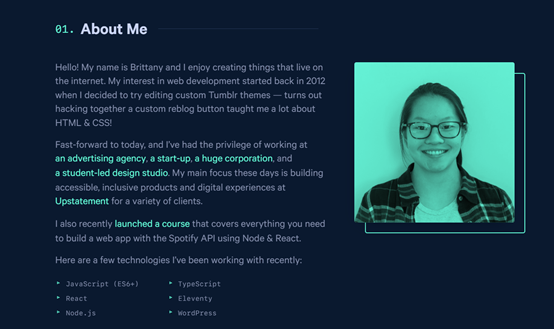
Add a short introduction to tell employers who you are, your work experience, skills, and education history. Include relevant information about your interests, why you want a career in programming, and the jobs you are looking for.
b) Projects section
Showcase all the projects you have worked on in the past. Be as creative as possible:
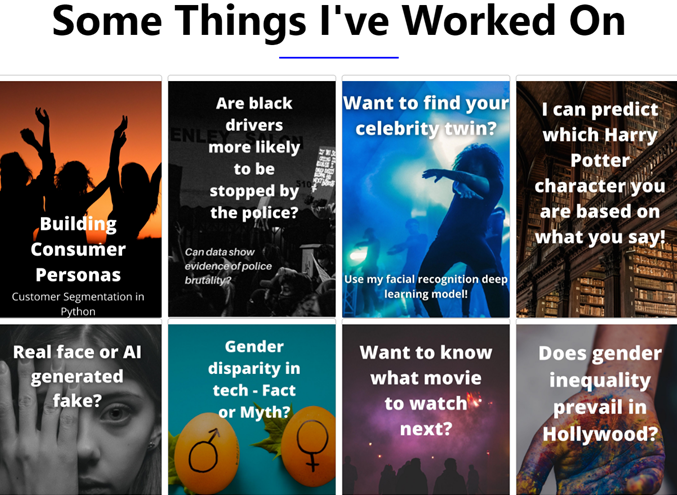
Include a description and source code so that people know what your projects are about:
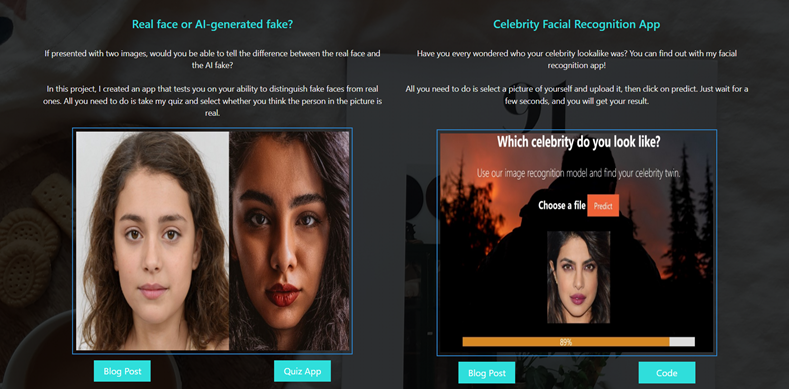
c) Contact page
Finally, add a contact section so that recruiters can easily get in touch with you. Here is an example of a creative contact page built by a developer using 3D animation features:
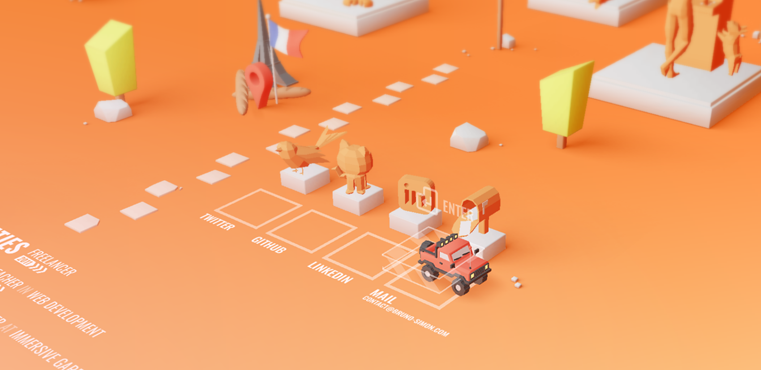
DataLab, Wix, and Github Pages are some free resources for hosting your portfolio website.
2. Enhance your social media presence
Next, create a LinkedIn profile and post content regularly. Whenever you learn an interesting concept or successfully complete a project, publish it on LinkedIn. Connect with other programmers, recruiters, and employers.
Engage with your network by commenting on their posts and joining programming groups where you can share valuable insight. This will help you gain recognition as a coder and improve your chances of getting noticed by recruiters.
It is important to show off your skills since the job market is competitive. A good idea is to create a blog and publish programming tutorials. Write an article about a new project every time you create one.
You can also create a YouTube channel to explain coding concepts and showcase personal projects.
3. Apply for jobs:
Finally, start applying to open positions that match your skill set. To maximize your chances of getting hired, tailor your resume to the job listings you apply to. Highlight projects that are relevant to the industry and explain why the role is the right fit for you.
For instance, if the job involves creating an end product for customers, display a project in which you implemented software that catered to user demand. Explain your interest in building client-facing applications to improve customer experience.
According to Indeed, submitting 2-3 job applications daily will increase your chances of getting hired.
To ensure you're fully prepared, you can practice some Python coding interview questions and look at how to build a data science resume.
Don’t just rely on cold submitting your resume to get a job. Find companies you want to work for and contact recruiters directly via email or LinkedIn. Share a link to your portfolio website with your connections and ask your network for referrals.
Attend programming meetups to expand your network. This is especially important if you did not pursue a degree and don’t already have an alumni network of programmers.
Becoming a Programmer Timeline
| Step | Description | Suggested timeline (full time) |
|---|---|---|
| Step 1: Select a programming language | Choose a language based on your career goals. Focus on one language initially to master it. | 1-2 Weeks |
| Step 2: Education | Learn the basics through degrees, bootcamps, or online courses. | 3-6 Months |
| Step 3: Coding challenges | Practice coding through online challenges and competitions. | 1-2 Months (Concurrent with Step 2) |
| Step 4: Projects | Build personal projects to apply your skills and showcase your abilities. | 1-3 Months (Concurrent with Step 3) |
| Step 5: Apply for programming jobs | Create a portfolio, enhance your online presence, and apply for relevant jobs. | 1-2 Months |
Suggested timeline to become an entry-level programmer.
Conclusion
Becoming a computer programmer is an exciting and rewarding journey with numerous career opportunities. The demand for skilled programmers is higher than ever, offering competitive salaries, job flexibility, and the ability to work remotely.
By following a structured approach—choosing a programming language, acquiring the necessary education, practicing coding challenges, developing personal projects, and actively seeking job opportunities—you can build a successful career in programming. Whether you're starting out or switching careers, this guide provides a clear roadmap to achieving your goals.
For more resources on programming, check out:
The prospects for computer programmers in 2025 are bright. With a strong foundation and a commitment to growth, you can look forward to a successful and fulfilling career in technology.
FAQs
Can I become a programmer without a degree, and will it affect my job prospects?
Yes, you can become a programmer without a degree. Many tech companies prioritize skills and experience over formal education. Self-taught programmers often use online courses, bootcamps, and personal projects to build their skills. While some employers may prefer candidates with a degree, many are more interested in your portfolio, problem-solving abilities, and practical experience.
How long will it take to become a computer programmer?
How long it will take you to become a programmer depends on the amount of time you spend coding. If you spend around 4 hours coding every day, you can land a job in less than six months. However, if you have a full-time job and other commitments, then it might even take up to a year or two for you to break into programming.
How to make money as a programmer?
A full-time job is the most common way to earn an income from programming, but it isn’t your only option. You can create a profile on freelance platforms and contract your coding skills to clients.
To generate passive income from programming, you can even build online courses or teach coding tutorials on YouTube.
Do I need to know advanced mathematics to become a successful programmer?
While advanced mathematics can be helpful in certain fields of programming, such as game development, data science, and machine learning, it is not a strict requirement for many programming jobs. Basic math skills and logical thinking are often sufficient for web development, software engineering, and other common programming roles.
What are some common mistakes beginners make when learning to code?
Some common mistakes include:
- Trying to learn too many programming languages at once instead of focusing on one.
- Spending too much time watching tutorials and not enough time practicing by writing their own code.
- Not asking for help or joining communities where they can share knowledge and solve problems collaboratively.
- Ignoring the importance of debugging skills and becoming frustrated by errors instead of learning from them.
How important is it to contribute to open-source projects for a programming career?
Contributing to open-source projects can be very beneficial. It allows you to work on real-world problems, collaborate with experienced programmers, and build a portfolio that showcases your skills. It also demonstrates to potential employers your ability to work in a team and your commitment to the programming community. However, it is not mandatory, and many successful programmers have built their careers without significant open-source contributions.
How do I stay current with the latest trends and technologies in programming?
Staying current with the latest trends and technologies is crucial in the fast-evolving field of programming. Here are some ways to stay updated:
- Follow tech blogs, forums, and news websites like Stack Overflow, GitHub, Medium and DataCamp.
- Join programming communities on platforms like Reddit, Discord, and LinkedIn.
- Attend webinars, conferences, and meetups.
- Take continuous education courses and certifications from reputable platforms.
- Experiment with new tools and frameworks through personal or open-source projects.

Natassha is a data consultant who works at the intersection of data science and marketing. She believes that data, when used wisely, can inspire tremendous growth for individuals and organizations. As a self-taught data professional, Natassha loves writing articles that help other data science aspirants break into the industry. Her articles on her personal blog, as well as external publications garner an average of 200K monthly views.

